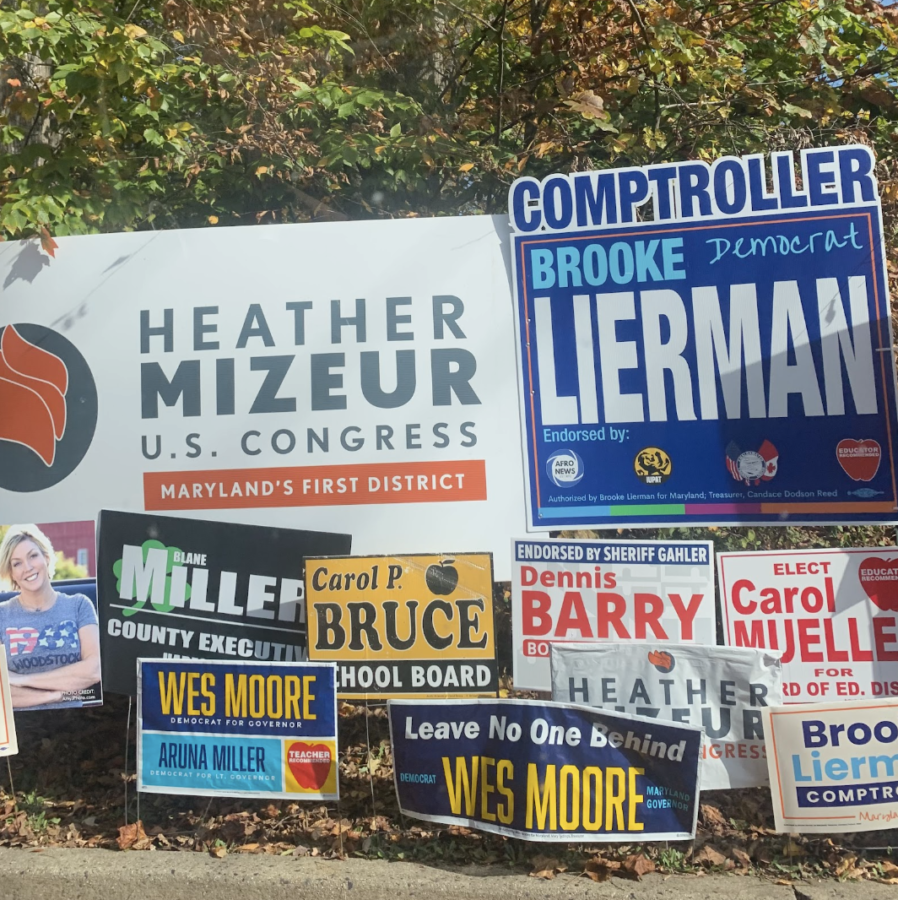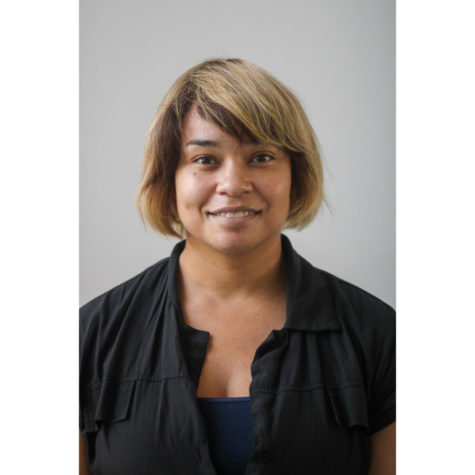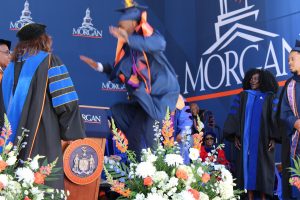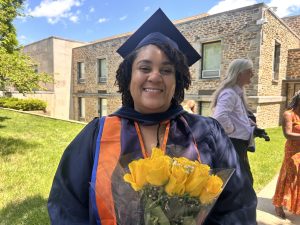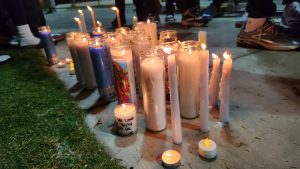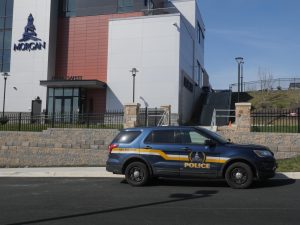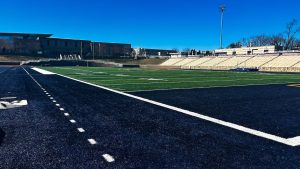A look at Maryland’s midterm election from 5 towns
Ahead of Tuesday’s election, the Spokesman reviewed how five towns in Maryland voted in previous midterm elections, and how things could play out this year.
Maryland counties gear up to elect candidates not only into state positions but local officials into offices.
November 7, 2022
As the Nov. 8 midterm elections quickly approach, Maryland voters look to cast their ballots on Tuesday.
The race for governor, attorney general, and comptroller have been followed closely by news outlets and voters within the state and throughout the nation.
However, Maryland counties gear up to elect candidates not only into state positions but will also vote for representatives of the Senate and Congress and will elect local officials into office.
Ahead of Tuesday’s election, the Spokesman reviewed how five towns in Maryland voted in previous midterm elections, and how things could play out this year.
Charles County: Waldorf
Edward Holland says that once a candidate wins the Democratic primary elections in Charles County, they are almost guaranteed to win the general elections in November.
“For a republican to win I would be surprised,” said Holland, president of the Veterans Democratic Club of Charles County and Vicinity.
Charles County is one of the most affluent predominantly-Black counties in the nation, with a median income of about $100,000.
The Southern-Maryland county’s voting history back-up Holmes’ claim. In 2018, Democratic candidates for comptroller, attorney general, U.S. senator and Congress representative won the county’s vote by at least 69.5 percent.
In fact, Larry Hogan lost the county’s vote for governor to Ben Jealous by a slim margin.
This record only echoes the results for the 2014 elections, in which Democratic candidates won the vote for almost all available seats. This excludes the Board of Education since all candidates identified as “non-partisan.”
Amanda Stewart, Charles County commissioner, agrees with Holland and believes that not many people feel high friction around seats on the ballot.
Stewart added that unlike many states with officials attempting to “turn back the clock” on accessible voting, Maryland and Charles County voters have had an easy time casting their ballots.
“Everyone that I’ve talked to has been pleasantly surprised and pleased,” she said
The county’s Board of Elections stated that long voting lines are likely due to the desire by many voters to use Ballot Marking Devices, an electronic voting machine which takes longer to use than a paper ballot.
“Finally, the Board takes our responsibilities regarding the conduct of elections very seriously,” said Craig Renner, president of the Charles County Board of Election in a letter responding to complaints from the National Association for the Advancement of Colored People about long lines at the Jaycees Community Center.
“[And] we would caution any elected official about the need to refrain from making allegations about voter suppression and racial disparities in voting without concrete evidence, as unfounded allegations about the conduct of elections have a potential, unintended effect of casting doubt on the integrity of our elections.”
In his letter, Renner said in the first four days of voting, 2,221 people cast their ballots at the Jaycees Community Center and that the center received an average of 42 votes per hour.
With little to no contention around seats up for elections, many Charles County voters have turned their attention to issues that concern them such as women’s rights, the economy and funding for public schools and teachers.
Stewart said that has heard many mixed feelings about the ballot question for the state’s legalization of marijuana, but feels like the most important thing this cycle is engagement from Maryland voters.
““People have the right to voice their opinions,” said Stewart. “[It’s important people] get out to vote and use their voice to share the importance of voting.”
Harford County: Aberdeen and Bel Air
Harford County is located in Northeast Maryland and is home to roughly 260,000 citizens. The county leans Republican and is typically a red county in the blue state of Maryland.
In 2014, Republicans Hogan and Boyd K. Rutherford ran for governor and lieutenant governor against Democrats Anthony G. Brown and Kenneth Ulman.
Hogan/Rutherford won the election with 51 percent of the votes to Brown/Ulman’s 47.3 percent, in what the Washington Post called “a stunning upset.”
That year, 91,460 Harford County citizens voted in the gubernatorial election out of the 166,500 people registered to vote.
According to the Maryland State Board of Elections, of those 91,460 voters, 69,986 (76.5 percent) voted to elect Hogan/Rutherford, whereas 19,814 (21.7 percent) voted to elect Brown/Ulman.
In 2018, Hogan and Rutherford ran for re-election against Democrats Ben Jealous and Susan Turnbull.
That year, Harford county voted overwhelmingly Republican, similarly to 2014, to re-elect Hogan and Rutherford.
110,579 Harford County citizens voted for Maryland State Governor in 2018, which was a 19,119-person increase from 2014.
Of those 110,579 voters, 85,259, or 77.1 percent voted to re-elect Hogan and Rutherford (R). 24,012 people or 21.7 percent of others voted to elect Jealous and Turnbull (D).
Many Harford County voters decided to vote early before Election Day, where crowds are expected to be larger.
Judy Muscgrave, Bel Air voter, expressed her top priority for the governor-elect, saying “I really hope that more can be done on the abortion issue.”
Muscgrave continued, “I’m very thankful Roe vs. Wade was overturned and turned back to the state’s choices but I would like to see more choices for the babies.”
Pam Nixson, another voter in Harford County, has different priorities including abortion right, however, she is doubtful that the election results in Harford County will reflect her views.
Tracey Waite of Harford County said she is concerned about what this year’s election results may hold and is sad that people are voting blindly for one party or familiar names, rather than evaluating the policy of candidates on both sides of the aisle.
Waite said people should know that they “think there are more progressive people in [Harford County] than people may be aware of.”
Frederick County: Frederick
The U.S. Census Bureau estimated 279,835 people resided in Frederick County in July 2021.
Barbara Wagner, Frederick County election director, said 195,000 people are registered to vote this election cycle. 16,000 of those voters took advantage of early voting between Oct. 27 and Nov. 3.
“The voting experience overall was very positive,” said Wagner. “We had plenty of election judges to assist the voters and very little wait times.”
Frederick County voters reflect a near 50-50 split in their elected officials, sometimes leaning toward democratic candidates.
Voters slightly favored Trump and Pence over Clinton and Kaine in 2016, with a 47-45 split. However in 2020, Biden and Harris took the majority vote with 53.3 percent, whereas Trump and Pence had only 43.7 percent in the county.
Frederick voters favored one democrat and one republican for their 2020 congressional representatives: Democratic Candidate David J. Trone in District 6, and Republican Candidate Gregory Thomas Coll in District 8.
In 2018, Frederick County voters preferred Republican candidate Hogan for governor, who had 67.7 percent of the vote.
Democrat Peter Franchot, a candidate for comptroller, had 59.2 percent of the vote and Democrat Brian E. Frosh, candidate for attorney general, had 51.1 percent.
The near-even division of republican and democratic candidates during the 2018 election cycle continued to the U.S. Senate, Maryland State Senate, Congressional representatives, House delegates, and so on.
Frederick voters preferred the democratic candidate for the U.S. Senate, one republican and one democrat for Congress, one democrat and one republican in the State Senate, and three democrats and four republicans for the Maryland House of Delegates during the 2018 election.
Voter turnout in Frederick County, which has historically seen several close races between political candidates, can easily tip these scales in one direction or the other.
Anne Arundel County: Crofton
Though the city of Crofton does not have individual election results, Anne Arundel County has routinely voted red since Hogan’s election in 2014.
Alternatively, Anne Arundel County overwhelmingly voted for Peter Franchot as comptroller, 63 percent to Republican candidate Anjali Reed Phukans’ 30 percent.
In 2014, Anne Arundel County voters voted for Hogan and Rutherford. The race for Maryland Comptroller was a close-call, with 52 percent of votes counted toward Franchot, and 47 percent counted toward Republican William H. Campbell.
Considering Anne Arundel County’s history with voting red in the past, it is not unlikely that Dan Cox will lead in votes from the Crofton area in this year’s gubernatorial election.
In the primary election, Republican candidate Dan Cox received the most votes from Anne Arundel County with 47.67 percent to Democratic candidate Wes Moore’s 31.50 percent.
Prince George’s County: Laurel
Unlike many predominantly-Black areas in Maryland Laurel has historically voted Republican in midterm elections.
Almost half of the city, located in north eastern Maryland is Black (49.8 percentage) and has a prominent white and Hispanic presence.
Starting in 2006, Laurel voted Democrat Martin O’Malley into the gubernatorial office with 162,899 votes and the same again in 2010 when O’Malley won by 203,957 votes.
It is a roll of the dice whether Laurel will vote Republican or Democrat during this Gubernatorial race due to the obvious party change the city of Laurel demonstrated over the years.
The Nov. 8 Midterm Elections
All voters will have the option of either casting a ballot electronically or by hand. They will complete their ballot and put it in the scanner to cast their vote. Voting officials will give them an “I voted” sticker and escort the voter outside of the polling place.
Same-day voter registration will be available on Election Day according to the Frederick County government website, https://frederickcountymd.gov.
Visit the Maryland State Board of Elections website to find your polling place: www.voterservices.elections.maryland.gov/pollingplace

